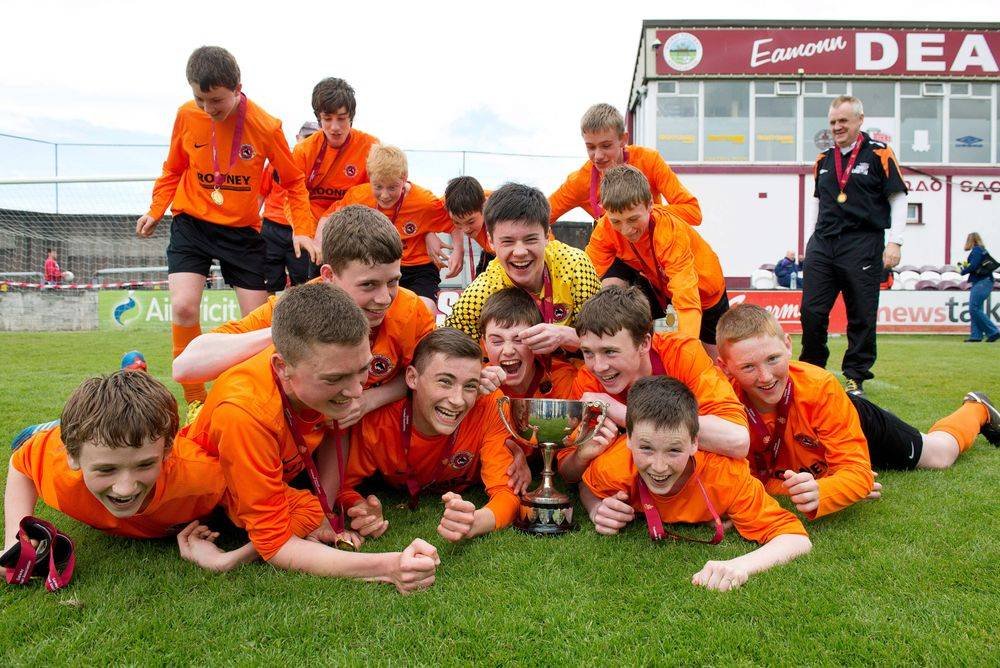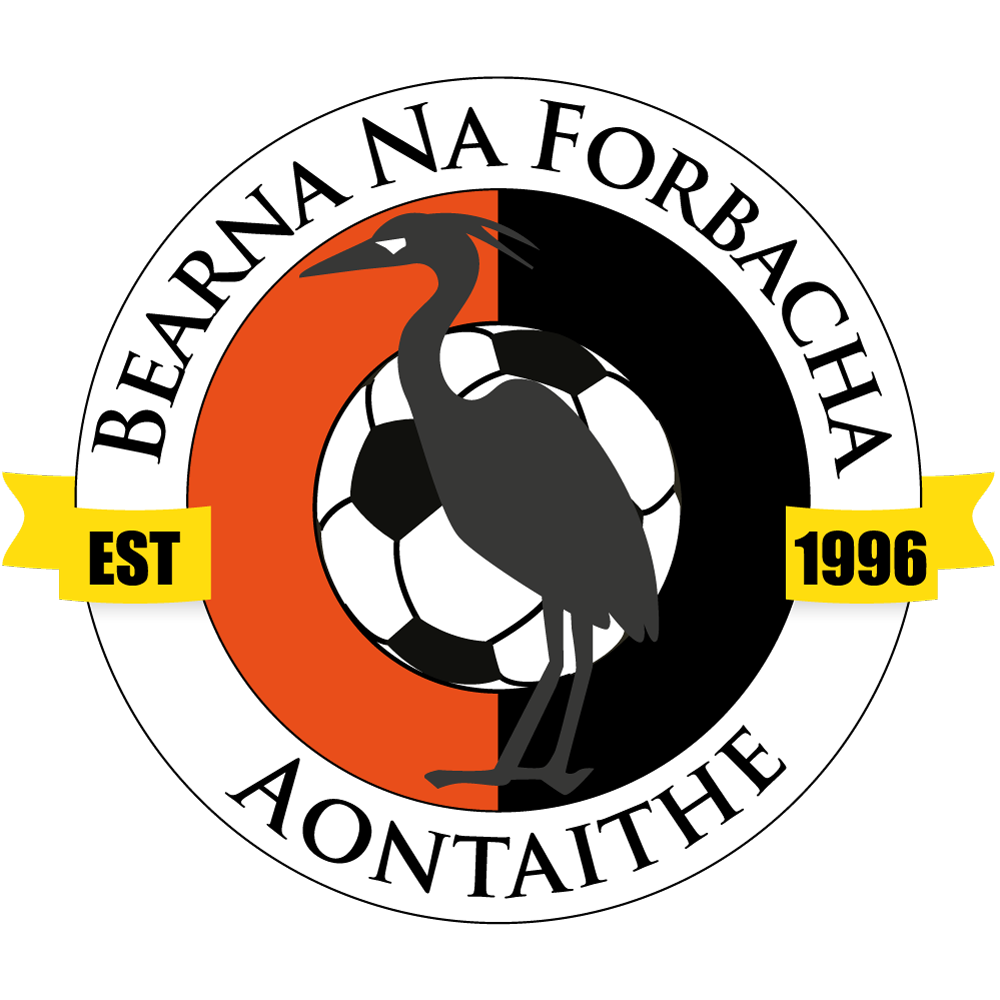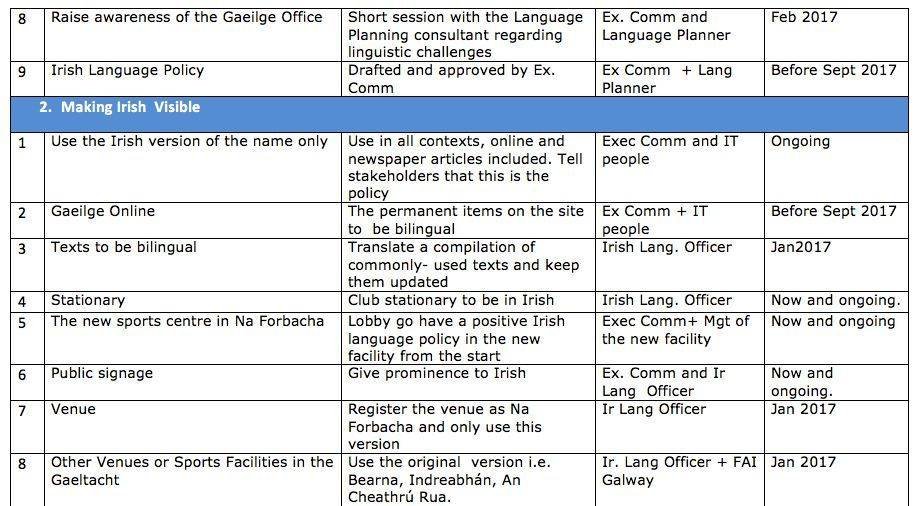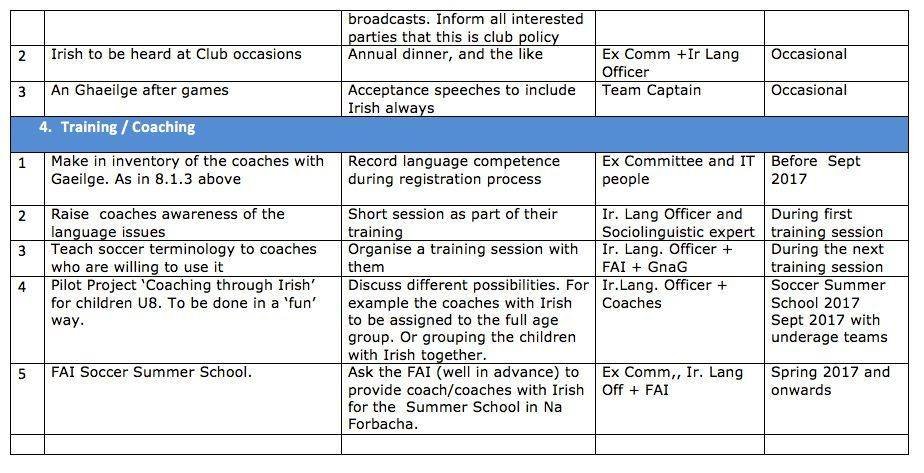
Language Plan
Language Plan
Bearna Na Forbacha Aontaithe is a Gaeltacht-based Club: and, as such, we have an obligation to promote and encourage the use of Irish among our members.
After all, 38% of the Club’s membership live within the within the Cois Fharraige Language Planning Area, which contains some of the strongest Irish speaking communities in the country, particularly west of An Spidéal.
Another 46% live in Bearna and Má Chuillinn which are officially Gaeltacht areas (though admittedly the use of Irish is weaker in these communities).
Moreover, unless we all do our bit to strengthen Irish as a family and community language, a significant element of our rich cultural heritage could soon be lost.
For these, and other, good reasons the Executive Committee has been working (with an external consultant) to prepare an Irish Language Plan for the Club.
Subject to obtaining the support of the membership, we should like to implement this Plan in early 2017.
Hopefully, the emphasis on the use of Irish (particularly with under-age teams) will provide the children with an opportunity to have an enjoyable Irish-language experience outside of the family or school environments.
And there should be no undue difficulty with this – as most local children already have a good grasp of Irish as a result of their attendance in nearby schools that have a particular emphasis on Irish.
We should also like to point out that:
This initiative will reinforce the case for the club seeking state funding now and in the future, as it is in line with Government Policy.
The costs of implementing the Plan are negligible.
It will strengthen the group identity of the Club and its members as being unique and special
The Plan poses no threat to the use of English but simply gives Irish a presence within the Club.
1. Introduction
It is timely that this plan is being put together since, as I understand it, the Cois Fharraige Language Plans is about to be implemented. The Club management is very aware that these language plans are being prepared in the context of the 20 Year Strategy for the Irish Language. We understand, as Club management, that we are a Gaeltacht club, although we are based on the eastern edge of Galway City. There is goodwill towards the language and we intend to build on this goodwill to implement a series of measures which are realistic and practical, for the purpose of normalising the use of Gaeilge in club activities both on and off the field. We are sincere and earnest in undertaking this project Current situation
Most of our clubs activities are organised through English. There are odd exceptions when volunteer coaches use the language during training. But this is on the basis of goodwill and depends on the ability of the coach, without any organised structure to it. In respect of the wider FAI, which is run though English, there is also goodwill there, and we intend to build on this too.
2. The Challenges
This is sports club and therefore our priority is to progress to excellence and to win competitions. Our motto is ‘Barr Feabhais a Chothú’ which is itself presented in Irish only. However English is the de facto language of management, administration and training in the club. The membership are not used to any other approach. We don’t have sufficient numbers of coaches to undertake all our training in Irish. There are also many players and members who have no Irish. As a result of our location on the fringe of the Gaeltacht, players come to us from outside the Gaeltacht as well as Gaeltacht areas defined as ‘Category C’.
3. The advantages
Because of our Gaeltacht location, we have a good number of players who come from the strongest Category A and B Gaeltacht areas. This is also the case with coaches. Also, most of the children have sufficient Irish, including those from Category C areas who are not being raised through Irish, to follow basic directions on the playing pitch. This is due to the very positive influence of the primary schools. We have already taken several measures to progress the Gaeltacht and Gaeilge identity of the club, changing the name of the club to its Irish version a few years ago and using only this version. We also sought to organise an interclub competition (underage) in Irish. We intend to attempt such a competition in the future.
4. Planning approach to the Language.
We understand that it is part of the planning process to create challenging but attainable targets. We also need to encourage the participation of all members so as to engender ownership of the plan. Since there is a culture and legacy of English use in the club, we intend to put particular emphasis on our youth. We will engage Language Planning professionals to put our plan together, to implement it and to monitor our progress. We will welcome any monitoring which the Department might require to confirm that progress is indeed being made.
5. Composition of Club Membership.
The club playing fields are Barr an Bhaile, Cnocán an Bhodaigh, at Na Forbacha. This forms part of the Cois Fharraige Language Planing Area according to The Gaeltacht Act 2012. This LPA extends from Na Forbacha as far west as Ros a’ Mhíl. More than 38% of our members live in this LPA, 127 out of 300. 46% of the others live on two other LPA, (Bearna and Maigh Cuillinn). In other words 94% of our members live in one or other Category of Gaeltacht:
Where are our members from?
6. Aims of the Language Plan
The aim of this LP is to normalise the use of Irish in the club within 5 years. That is, to give Irish status, recognition and presence in the club. We must be realistic in this aim, and although Irish speakers are a minority in the area where the club operates they should be able to use the language without having to be apologetic about it.
In addition, the plan aims to give young players an enjoyable experience of speaking Irish in an environment beyond the school and the family.
This experience, in conjunction with the school and the Irish-speaking families will strengthen the preservation and development of the language as an option in this community in the future.
9. Costs
Most of the above recommendations can be implemented cost- free
There will be cost attached to compiling the handbook (8.1.5 above). This should be discussed with Glór nan Gael and the FAI to get them on board
There will be a cost associated with updating the internet site (8.2.2 above) to make Irish more visible on it. This could be discussed with a third-level institution with a view to giving it as a project to a student.
10. Monitoring
It is recommended that the Irish Language Officer (ILO) should provide the Executive Committee with a report in April 2017, and annually thereafter. This report would comprise the progress or otherwise in respect of Irish usage in the Club. If funding is provided by the Dept of Arts Etc, then a copy should be sent to them annually each May.
11. Language Policy
(8.1.9 above). The club employs various other policies to give direction to the membership in various areas. These include the FAI Code of Conduct for Coaches, the FAI Code of Conducts for Parent, and Goal Post Safety etc.
In the same way, we recommend that the Club drafts a Gaeilge Policy which will be a guide to club members in the future in respect of the status and use of Irish in the club.
12. Abbreviations
CG: Executive Committee
FAI: Football Association of Ireland
GnaG: Glór na nGael
OG: Irish Language officer
LPT: Language Planning Area




